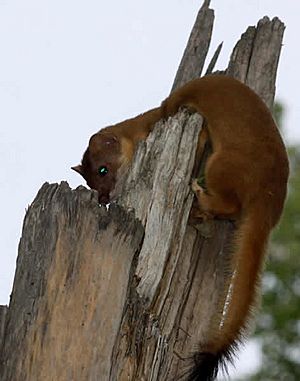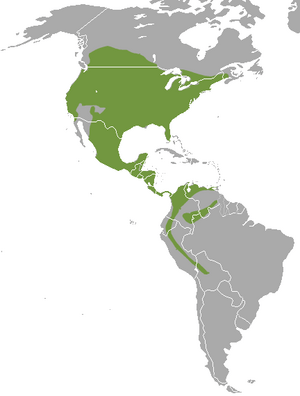Long-tailed weasel facts for kids
Quick facts for kids Long-tailed weasel |
|
|---|---|
 |
|
| Conservation status | |
| Scientific classification | |
| Genus: |
Mustela
|
| Species: |
frenata
|
 |
|
| Long-tailed weasel range | |
The long-tailed weasel (Mustela frenata) is a quick and clever animal. It's a type of mustelid, which is a family of animals that includes badgers and otters. People sometimes call it the bridled weasel or big stoat. These weasels live across a huge area, from southern Canada all the way through the United States, Mexico, Central America, and into northern South America.
Contents
What Does a Long-Tailed Weasel Look Like?
Long-tailed weasels are quite small, but males are usually bigger than females. Males are about 12 to 16 inches (330–420 mm) long, not including their tail. Females are a bit smaller, around 11 to 13 inches (280–350 mm) long. Their tails are also long, adding another 5 to 11 inches (132–294 mm) for males and 4 to 9 inches (112–245 mm) for females. These weasels weigh between 3 and 9 ounces (85-267 g). Males can be twice as heavy as females!
In the summer, their fur is brown on top and whitish underneath. It might have a yellowish or light brown tint. Their tail always has a black tip, no matter the season. In colder, northern places, their winter fur turns white, sometimes with a yellow hint. But that black tail tip stays the same! Long-tailed weasels shed their fur twice a year, once in the autumn and again in the spring. This helps them change their coat for the new season. Unlike skunks, which spray a stinky liquid, weasels mark their territory by rubbing their bodies on things. They also do this to scare away predators if they feel scared.
Where Do Long-Tailed Weasels Live?
Long-tailed weasels live in many parts of North America, reaching south into Central America and northern South America. They have the widest range of any mustelid in the Western Hemisphere. This means they live in more places than any other weasel-like animal in the Americas!
You can find long-tailed weasels in many different habitats, from warm tropical areas to cooler places. They live in farm fields, small wooded areas, and even near suburban neighborhoods. However, they usually don't live in very dry deserts or very thick forests. They make their homes in places like hollow logs, piles of rocks, or under barns. Sometimes, instead of building a new nest, they might take over the burrow of an animal they've hunted.
How Do Long-Tailed Weasels Behave?
Long-tailed weasels are mostly solitary animals, meaning they live by themselves. They only come together during the mating season. They don't like other weasels entering their home area.
These weasels are very fast and agile. They are excellent climbers and good swimmers too. They use their strong sense of smell and hearing to find their prey. While they can be active during the day, they are usually more active at night. Long-tailed weasels are known to make noise, but this often means they are feeling disturbed or threatened.
What Do Long-Tailed Weasels Eat?
The long-tailed weasel is a carnivore, which means it eats meat. It's a fierce hunter and can even attack animals much larger than itself! They mostly hunt small animals like mice, rats, squirrels, chipmunks, shrews, moles, and rabbits. They are very helpful to farmers because they control the populations of these rodents and rabbits, which can be pests.
Long-tailed weasels prefer to eat fresh or live prey. They only eat carrion (dead animals) if they have stored it in their burrows. Besides rodents and rabbits, they might also eat small birds, bird eggs, reptiles, amphibians, fish, earthworms, and some insects. They have even been seen eating bats! Sometimes, they kill more animals than they can eat, especially in the spring when they are feeding their babies, and again in the autumn. They might store some of these extra kills, but often leave them uneaten. When they steal eggs, they carry each one carefully in their mouth to a safe spot. Then, they bite off the top and lick out the liquid inside. If they have babies, they might carry the whole egg back to their burrow for them.
Who Hunts Long-Tailed Weasels?
Even though long-tailed weasels are good hunters, they can also become prey for larger animals. Their predators include big owls, coyotes, and large snakes like eastern massasauga rattlesnakes.
Life Cycle and Reproduction
Long-tailed weasels usually mate in July or August. The babies, called kits, are born about 10 months later, in April or May. A mother weasel typically gives birth to 5 to 8 kits at a time.
When they are born, the kits are partially naked and cannot see. They weigh only about 3 grams, which is super tiny! But they grow very fast. By the time they are three weeks old, they have a lot of fur. They can even crawl out of the nest and start eating meat. At five weeks old, their eyes open, and they become much more active. This is also when they stop drinking their mother's milk (this is called weaning). The kits are fully grown by the autumn. At this point, they leave their family to live on their own. Female weasels can start having their own babies when they are only 3 to 4 months old. Males become old enough to breed when they are about 15 to 18 months old.
Why Are Long-Tailed Weasels Important?
The fur of long-tailed weasels was sometimes used in the fur trade, but it was not as popular as other furs. Farmers often like having long-tailed weasels around their farms because these weasels are excellent at catching rats and mice. This helps control these pests that can damage crops or stored food. However, long-tailed weasels are also known to sometimes take poultry (like chickens) from farms.
Images for kids
-
Skulls of a long-tailed weasel (top), a stoat (bottom left) and least weasel (bottom right), as illustrated in Merriam's Synopsis of the Weasels of North America
-
Black-tipped tail, brown and yellowish fur, and long whiskers distinguish this Long-tailed weasel in Seattle, Washington
See also
 In Spanish: Mustela frenata para niños
In Spanish: Mustela frenata para niños








